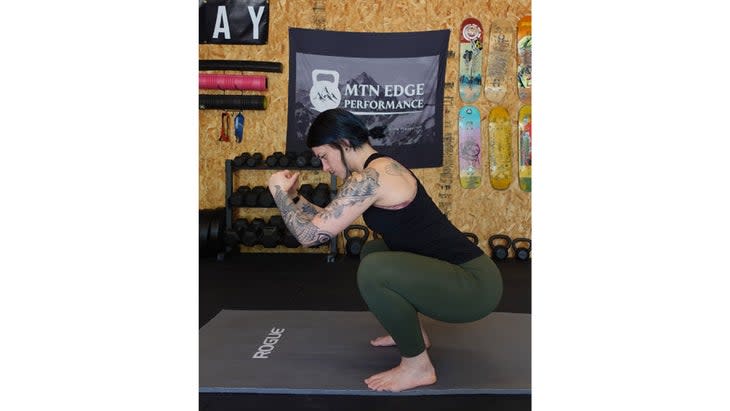The 4 Most Common Squat Mistakes, According to a Strength Coach
This article originally appeared on Outside
Squats may be the most common movement in your training regime, but you're likely doing them incorrectly. Sure, they can seem like an easy, straightforward exercise, but executing them well is difficult. This movement engages your glutes, quads, hamstrings, hips, and core. If even one muscle group isn’t activated correctly, your entire form could be off.
As a strength coach, I always recommend nailing the basics of a bodyweight squat before adding on weight or trying more complex variations. If you add on too much weight or perform too many reps without the proper training, you can become injured.
The first step to cleaning up your squat mechanics is to watch yourself doing them. Try squatting in front of a mirror or taking a video of yourself to reference as you go through these common mistakes.
1. You're Not Creating Torque
You may be focused on your quads and glutes when you squat. And while you're not wrong to do so, strong squat form starts from the ground up. Yes, I'm referring to your feet--the most important base of support in this movement.
The concept of torque refers to rotational force, a critical factor in your ability to create stability in your hips when you squat. To achieve this, think about screwing your feet into the floor. Turn your right foot clockwise and your left foot counterclockwise. When you do this, you should feel the arches in your feet lift.
This slight adjustment will ensure you are in the most stable position to squat. You'll likely notice a huge increase in your power after learning how to create torque effectively through your feet.
2. You're Not Maintaining a Neutral Pelvic Position
An excessive anterior or posterior pelvic tilt during a squat can significantly increase your risk of pain in your hips, knees, and back. If you find your lower back rounding or arching at the bottom of your squat, this is an indicator of pelvic tilt, which can make this exercise uncomfortable and even painful.
How to Prevent Pelvic Tilt When You Squat:
1. Stand in a neutral position with your tailbone slightly tucked. Squeeze your glutes. Make sure your head is stacked directly over your spine.
2. Keep your ribcage pinned down. Contract your core as you begin to load your hips.
3. As you hinge from your hips, drive your knees out laterally by pushing through your feet and lower into a squat position. Maintain a flat back.
4. As you stand back up, drive away from the floor and push your hips under your torso, squeezing your glutes at the top to set your pelvis in a neutral position.
3. Your Head's in the Wrong Position
Proper head positioning during a squat can enhance your stability and power. If your head is out of neutral alignment, it can make it difficult to balance, cause excessive pelvic tilt, and prevent your core muscles from stabilizing your spine.
Think about slightly tucking your chin and focusing your gaze at a spot on the floor in front of you. Your eyes should stay focused straight ahead. Like your back, you don't want your neck to be rounded or arched. Doing so can potentially cause pain and injury.
4. You're Allowing Your Knees to Collapse Inward
As I explained in the first tip, creating torque will help prevent your knees from collapsing inwards as you squat.
As you screw your feet into the floor, the arches of your feet should lift. This will help your knees stay in alignment with your feet, ankles, and hips. If your ankles or knees continue to cave inwards in a low squat, you may have some mobility restrictions through your hips or ankles.

How to Perform a Squat with Proper Form
1. Your foot positioning will vary slightly depending on your individual body. However, a good rule is to distance your feet approximately shoulder-width apart. Your feet can be pointed straight ahead or turned slightly outwards.
2. Create torque by screwing your feet into the ground and driving them out toward your pinky toes. This will help create hip stability.
3. Squeeze your glutes. Make sure your ribcage is down, and your head is back. Everything should be stacked in alignment with your spine.
4. Keep your shins perpendicular to the floor as you lower down into a squat. Tighten your core and squeeze your shoulder blades toward your spine.
5. Maintain the torque through your feet, driving your knees out as you come up from the squat and push away from the floor.
6. Squeeze your glutes at the top to complete the rep. Find a neutral alignment before starting the next rep.
Taking the time to optimize your squat mechanics will improve strength and power outputs in training--and on the trails.
For exclusive access to all of our fitness, gear, adventure, and travel stories, plus discounts on trips, events, and gear, sign up for Outside+ today.

